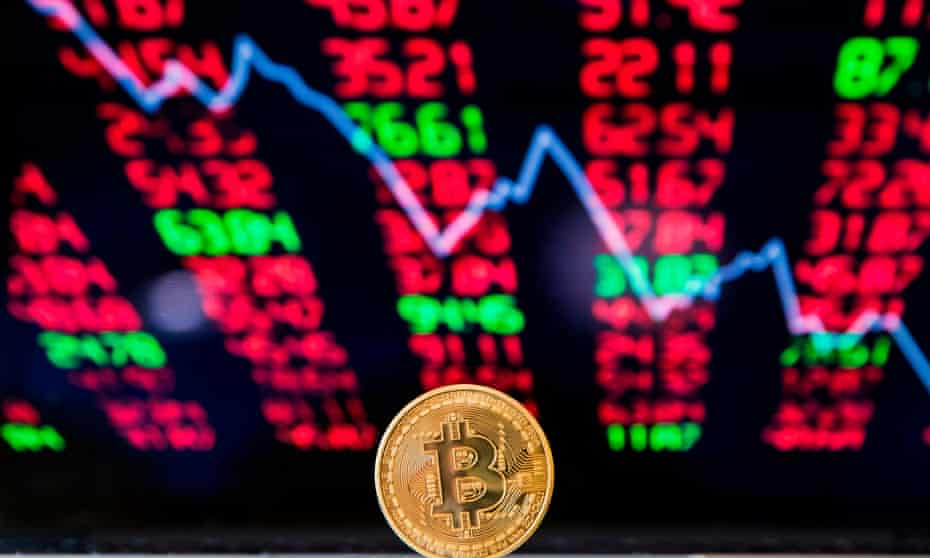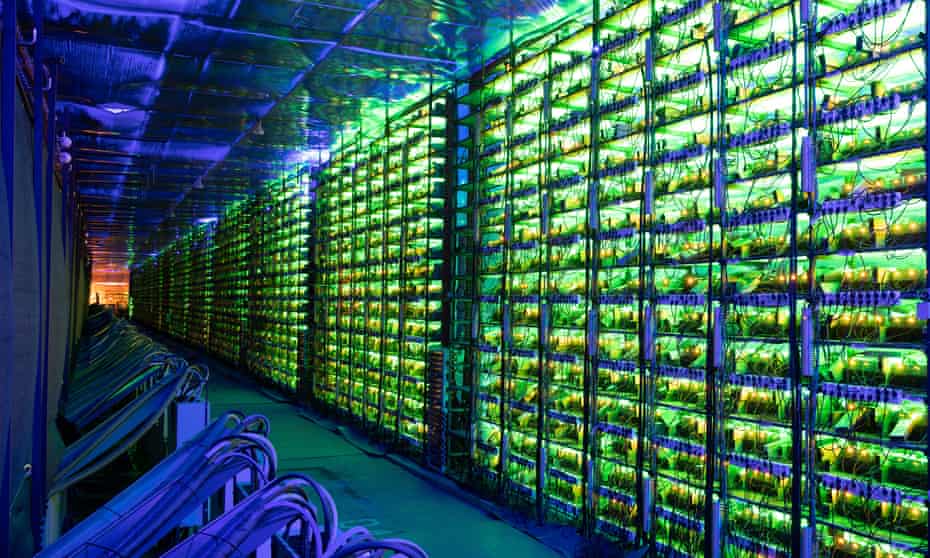The rising price of electricity and the plunging value of the cryptocurrency could burst the speculative bubble for today’s prospectors writes John Naughton in The Guardian
 Bitcoin mining has previously produced lucrative gross margins as high as 90%. Photograph: Jack Guez/AFP/Getty Images
Bitcoin mining has previously produced lucrative gross margins as high as 90%. Photograph: Jack Guez/AFP/Getty Images
In the bad old days, prospecting for gold was a grisly business involving hysterical crowds, pickaxes, digging, the wearing of appalling hats, standing in rivers panning for nuggets, “staking” claims and so on. The California gold rush of 1848-55, for example, brought 300,000 hopefuls to the Sierra Nevada and northern California and involved the massacre of thousands of Indigenous people.
In our day, the new gold is bitcoin, a cryptocurrency, and prospecting for it has become a genteel armchair activity, although it is called “mining”, for old times’ sake. What it actually involves is using computers to perform unfathomably complicated calculations to create cryptographic “hashes” – codes that are, in practical terms, uncrackable.
Sounds intimidating, doesn’t it? But in reality anyone can play the game. You just have to have the right kit – a special bitcoin-mining computer called an Asic (application-specific integrated circuit). These gizmos are readily available online. I’m looking at one as I write: the Bitmain Antminer S19, which costs $6,999 (£5,600) and can do 95 terahashes – 95tn calculations – every second.
Mining is a misleading term for the computational work that’s needed to validate transactions on the blockchain – the cryptographically protected distributed ledger that underpins bitcoin. For every “block” that a miner is able to validate, they are rewarded with a number (currently 6.3) of new bitcoins. The value of the reward is tied to the prevailing price of the currency at the time. Not so long ago, for example, when each bitcoin stood at $68,000, that reward was worth nearly $430,000.
So you can understand why bitcoin mining looks a bit like a contemporary version of what happened in California in the 1840s. While most of the hopeful arrivals then were Americans, there were also thousands from Latin America, Europe, Australia and China. The Judge Business School in Cambridge, which has been tracking bitcoin mining for years, now finds that the US, with 37.84% of global hashrates, remains the biggest location, followed by China (21.11%), Kazakhstan (13.22%), Canada (6.48%) and Russia (4.66%).
So bitcoin mining has become a global phenomenon. And while here and there there are small outfits diversifying into it, such as the Californian pancake-batter maker that bought an Asic after pancake sales plunged during the pandemic, most miners are now industrial-scale operations with large sheds of Asics in serried racks, looking for all the world like small-scale data centres of the kind run by Google and co.
And, like data centres, they are power-hungry. That Bitmain Antminer machine, for example, has a power rating of 3,250 watts. It was recently estimated that bitcoin consumes about 110 terawatt hours per year, which is 0.55% of global electricity production, or roughly equivalent to the annual energy draw of countries such Malaysia or Sweden.
For many operators, bitcoin mining has up to now been an astonishingly lucrative activity, with gross margins sometimes as high as 90%. But suddenly things have changed. First, bitcoin’s price has plunged – from its peak of $68,000 to $30,587 as I write this. And second, electricity prices have soared – by up to 70% in parts of the world, leading some industry experts to calculate that mining a single bitcoin can now cost up to $25,000. So the industry finds itself squeezed at both ends. Just like any ordinary business, in other words.
There’s an agreeable sense of schadenfreude in all this. Bitcoin has been a fascinating phenomenon from the very beginning, but one that morphed under the pressure of greed. Originally conceived as a currency – that is, as a means of payment – it rapidly became perceived as an asset class and, in a time of low interest rates, was the subject of an hysterical speculative bubble that now seems to have deflated, even if it hasn’t definitively burst.
Although it was predictable from the outset that, as the currency evolved, maintenance of its underpinning cryptographic blockchain would become ever-more onerous, it took a long time for the environmental consequences of that fact to be realised. But perhaps that’s a hallmark of every speculative bubble. It’s always difficult to get people to understand something if their wealth – real or anticipated – depends on their not understanding it. Meanwhile, the rest of us are left with the realisation that even the coolest idea can fry the planet.
 Bitcoin mining has previously produced lucrative gross margins as high as 90%. Photograph: Jack Guez/AFP/Getty Images
Bitcoin mining has previously produced lucrative gross margins as high as 90%. Photograph: Jack Guez/AFP/Getty Images In the bad old days, prospecting for gold was a grisly business involving hysterical crowds, pickaxes, digging, the wearing of appalling hats, standing in rivers panning for nuggets, “staking” claims and so on. The California gold rush of 1848-55, for example, brought 300,000 hopefuls to the Sierra Nevada and northern California and involved the massacre of thousands of Indigenous people.
In our day, the new gold is bitcoin, a cryptocurrency, and prospecting for it has become a genteel armchair activity, although it is called “mining”, for old times’ sake. What it actually involves is using computers to perform unfathomably complicated calculations to create cryptographic “hashes” – codes that are, in practical terms, uncrackable.
Sounds intimidating, doesn’t it? But in reality anyone can play the game. You just have to have the right kit – a special bitcoin-mining computer called an Asic (application-specific integrated circuit). These gizmos are readily available online. I’m looking at one as I write: the Bitmain Antminer S19, which costs $6,999 (£5,600) and can do 95 terahashes – 95tn calculations – every second.
Mining is a misleading term for the computational work that’s needed to validate transactions on the blockchain – the cryptographically protected distributed ledger that underpins bitcoin. For every “block” that a miner is able to validate, they are rewarded with a number (currently 6.3) of new bitcoins. The value of the reward is tied to the prevailing price of the currency at the time. Not so long ago, for example, when each bitcoin stood at $68,000, that reward was worth nearly $430,000.
So you can understand why bitcoin mining looks a bit like a contemporary version of what happened in California in the 1840s. While most of the hopeful arrivals then were Americans, there were also thousands from Latin America, Europe, Australia and China. The Judge Business School in Cambridge, which has been tracking bitcoin mining for years, now finds that the US, with 37.84% of global hashrates, remains the biggest location, followed by China (21.11%), Kazakhstan (13.22%), Canada (6.48%) and Russia (4.66%).
So bitcoin mining has become a global phenomenon. And while here and there there are small outfits diversifying into it, such as the Californian pancake-batter maker that bought an Asic after pancake sales plunged during the pandemic, most miners are now industrial-scale operations with large sheds of Asics in serried racks, looking for all the world like small-scale data centres of the kind run by Google and co.
And, like data centres, they are power-hungry. That Bitmain Antminer machine, for example, has a power rating of 3,250 watts. It was recently estimated that bitcoin consumes about 110 terawatt hours per year, which is 0.55% of global electricity production, or roughly equivalent to the annual energy draw of countries such Malaysia or Sweden.
For many operators, bitcoin mining has up to now been an astonishingly lucrative activity, with gross margins sometimes as high as 90%. But suddenly things have changed. First, bitcoin’s price has plunged – from its peak of $68,000 to $30,587 as I write this. And second, electricity prices have soared – by up to 70% in parts of the world, leading some industry experts to calculate that mining a single bitcoin can now cost up to $25,000. So the industry finds itself squeezed at both ends. Just like any ordinary business, in other words.
There’s an agreeable sense of schadenfreude in all this. Bitcoin has been a fascinating phenomenon from the very beginning, but one that morphed under the pressure of greed. Originally conceived as a currency – that is, as a means of payment – it rapidly became perceived as an asset class and, in a time of low interest rates, was the subject of an hysterical speculative bubble that now seems to have deflated, even if it hasn’t definitively burst.
Although it was predictable from the outset that, as the currency evolved, maintenance of its underpinning cryptographic blockchain would become ever-more onerous, it took a long time for the environmental consequences of that fact to be realised. But perhaps that’s a hallmark of every speculative bubble. It’s always difficult to get people to understand something if their wealth – real or anticipated – depends on their not understanding it. Meanwhile, the rest of us are left with the realisation that even the coolest idea can fry the planet.
 Illuminated rigs at the Minto cryptocurrency mining centre in Nadvoitsy, Russia. Photograph: Andrey Rudakov/Getty Images
Illuminated rigs at the Minto cryptocurrency mining centre in Nadvoitsy, Russia. Photograph: Andrey Rudakov/Getty Images